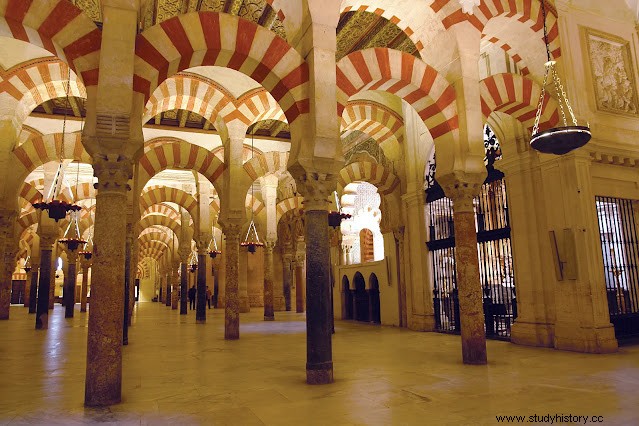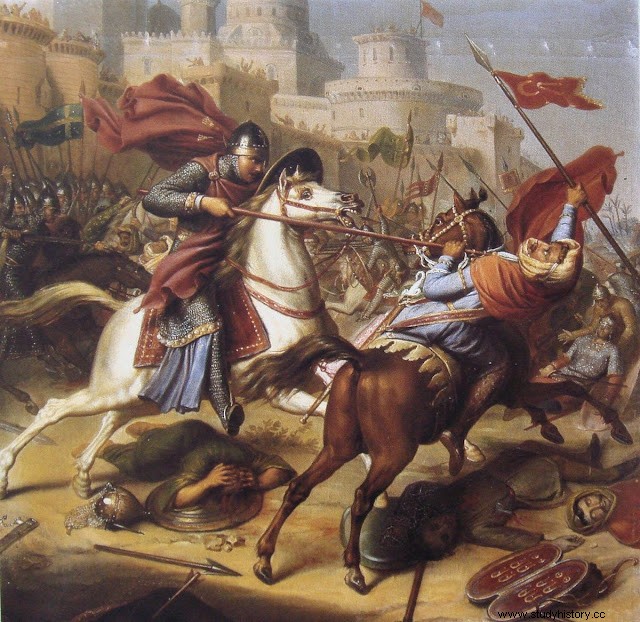"The academic world has sought to contrast the image of an Edenic al-Andalus with that of a fanatical, backward and genocidal Spain"
How did the Christians of Al Andalus disappear? This was the life and resistance of the Mozarabs.
 The Arab leader Almanzor captured Christian slaves in his military raids
The Arab leader Almanzor captured Christian slaves in his military raidsJuly 19, 711 begins the decisive fight, known as the battle of Guadalete, which will definitively open the doors of Hispania to eight centuries of Muslim occupation. The Gothic king Rodrigo is defeated and his control over the Peninsula fades. With the conquest of Hispania, the dazzling Arab expansion that began after the death of Muhammad in 632 culminated in the West. In just 10 years, the armies of the caliphs (the successors of the Prophet at the head of the Muslim community) had taken over Near East to Egypt.
This regime lasted centuries in the Peninsula, until on January 2, 1492, Muhammad XII, or Boadil, as the Christians knew him, handed over the keys of Granada, the last Andalusian kingdom, to The Catholic kings. For this reason, every 12 months, the Andalusian city celebrates this date. However, in recent years, different organizations have opposed this commemoration, calling it xenophobic. A current that is based on some studies, discussed by experts, who consider that Al-Andalus was an example of perfect coexistence between three religions:Islam, Judaism and Christianity.
According to historian Rafael Sánchez Saus: "Those who put Al-Andalus as an example of tolerance are doing brutal manipulation in historical terms"
 Evolution of the peninsular kingdoms
Evolution of the peninsular kingdomsDuring the 8th century and the first decades of the 9th, the Christian population It was a vast majority, around 90% of the population of Al Ándalus. At first, this Christian population was able to maintain its autonomy, regulated by agreements produced at the time of the conquest. The Christians in Al-Andalus were designated as Mozarabic but not by the Muslims but by the Christians of the north when they emigrated to their territories to indicate their linguistic specificity:they spoke Arabic, and not a Romance language derived from Latin. The first document in which the term appears is from the kingdom of León and is dated 1024.
Those pacts soon gave way to the dimma system. Christians and Jews could practice worship with great limitations, and in exchange for this they were subjected to a set of discriminatory and humiliating rules in their personal, social and daily life, as a price to pay for living in a country subjected to Muslim power. All the legislation, any disposition and the spirit of the norms tended to subdue, making clear the humiliation, the weakness and the defeat of the Christians, who had to pay higher taxes. The Christian only had two ways out:either he apostatized from the faith or he became little less than a slave. Although they were unarmed and demoralized, the Mozarabs staged numerous rebellions and protests while they were the majority.
"The tolerance of Al Andalus is a tale of a thousand and one nights"
The first thing we must bear in mind when analyzing the fate of the Mozarabs is that the Arab chronicles barely mention them. We know that there were rebellions because some of them are narrated, especially when they are crushed, but we do not know how many, or because of Christian sources.
Through the dimma, the Christian or Jew recovered a part of the denied rights. This non-Muslim was required to pay two taxes. One was the jarach, on the land, which could reach half of the harvest, and without reductions (on top of that, the debt accumulated in the heirs), while the Muslim paid between 5% and 10%. The other was the jizya, which was personal, in exchange for the Islamic community sparing his life. Its amount varied and its payment was made in public and under humiliation; in the reign of Abderramán III it was paid four times a year.
As Christians were the majority of the population of Al Andalus until the 10th century, we find ourselves before a colonial system, in which an armed and savage minority lives in opulence through the legal plunder of the subjugated majority.
Despite segregation and the violence they suffered, which they could escape in part by abjuring their faith, Christians resisted absorption for centuries. According to Richard W. Bulliet, at the end of the 8th century only 10% of Andalusians were Muslim; 20% a century later; in the middle of the X, at the height of the caliphate, 50%; and at the beginning of the 11th century, already 80%.
 Arab painting of the time
Arab painting of the timeWe will mention some unusual laws applied to Christians. For example, a Christian who killed a Muslim, even in self-defense, was inevitably sentenced to death - not the other way around. A testimony of a follower of Christ against a member of Islam was worthless in court. A Christian had to get up if a Muslim entered the room, he could only pass him on the left side (considered cursed), and he could not ride a horse in his presence. Nor could he count on servants of that religion, nor could the home of a follower of the doctrines of Christ be higher than that of an Arab to the point of, in that case, having to demolish the upper floor.
There was discrimination against minorities in Al-Andalus:persecution of Jews and Christians by Muslims, massive deportations of Christians and Jews to North Africa, great massacres of Jews in Granada in the 11th century... Of course, then the Christians did exactly the same with Muslims. There was harsh harassment and discrimination.
This perverse regime was maintained on the peninsula for centuries, so the reality of life for Christians in Al-Andalus has little or nothing to do with the self-serving daydreams that nourish a myth built at the expense of historical truth. The academic world has sought to contrast the image of an Edenic al-Andalus with that of a fanatical, backward and genocidal Spain .
 Great Mosque of Córdoba
Great Mosque of CórdobaAfter the disappearance of the Caliphate of Córdoba in the year 1031, the situation of Mozarabic Christianity was practically irreversible. With the arrival of the Almoravids first, in 1086, and of the Almohads later, from 1145, a period began that was no longer one of pressure, but of marginalization and annihilation. Deportations to North Africa, the persecution and destruction of churches and massacres began to be frequent. The Mozarabic Christians responded with a massive emigration of all they could to the north, to the Christian kingdoms.
This is how the heiress of Spanish Christianity ends, so that around 1150 all trace of them is lost. It can be said that as of this time, there are no longer any Christian communities in al-Andalus. There could have been small groups, isolated and in a precarious situation, but the ecclesiastical structure had been completely eliminated.
In previous decades, when the Taifa kingdoms fell to Christian attacks, many Mozarabs took the opportunity to collaborate with their brothers in faith or escape. Alfonso I of Aragon, who entered Al Andalus in 1125, returned to his land with no less than 10,000 Mozarabs. The Almoravids deported thousands of Mozarabs to Morocco in the first decades of the 12th century.
However, the Mozarabs of the 11th and 12th centuries were not always received with open arms by the free Christians. These had come off neo-gothicism, insufflated by the Mozarabic clergy who had emigrated to Oviedo and León since the eighth century, and although it had allowed Christian Spain to survive in that dark age, its restoration was neither possible nor could it encourage the Hispanic Christianity to expel the invaders by their own forces.
In Spain, the Camino de Santiago and the Cluniac monks (called by the monarchs to rebuild the monasteries destroyed by Almanzor) brought the new Catholic ideas and the spirit of crusade. The kings of León, Navarra, Castile and Aragón had agreed to replace the national liturgical rite, which the Mozarabs continued to practice, with the Roman one. In the reconquered Toledo (1085) there was such a profound conflict that the pope granted the privilege of maintaining it in six parishes.
 Battle of the Reconquest
Battle of the ReconquestFurthermore, due to the process of acculturation that they had suffered for centuries –and the failure of their Gothicism to defend themselves against it-, the Mozarabs were so Arabized that they used Arabic names and were circumcised (habits practiced even by clerics), they spoke Arabic better than the Romance languages and the Latin, dressed in the oriental style and claimed descent from Arab personalities. Several heresies were also rooted in them due to Islamic influence, especially those that denied the divinity of Christ or the Trinity, such as adoptionism, defended by an archbishop of Toledo, Elipando.
Thus concluded a community that suffered unspeakably in its own land for loyalty to Christ and the Church.
